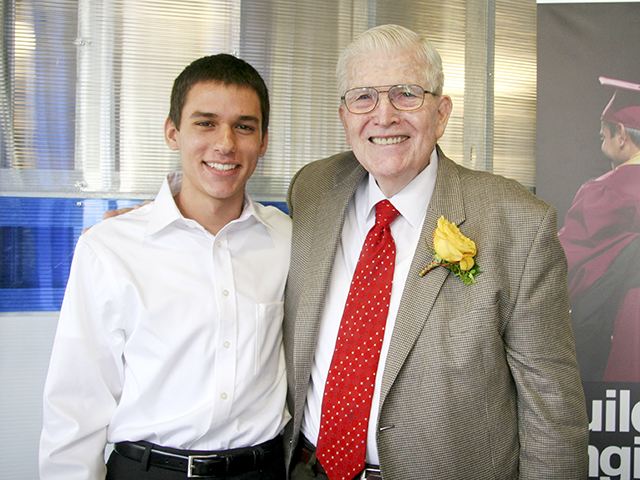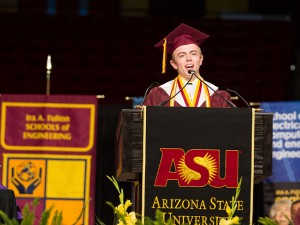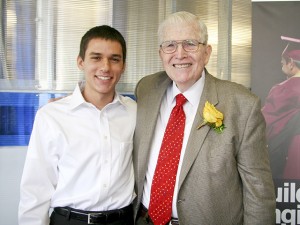
FURI paves way to graduate school, career goals


Nathan Gaw is pursuing his master’s degree as part of the 4+1 program, and was the student speaker at the Spring 2013 Fulton Engineering convocation, where he received his bachelors degree in biomedical engineering. Photo by: Jessica Hochreiter/ ASU.
Undergraduate engineering research program helps open paths to students’ success
Nathan Gaw got interested in neuroprosthetics during his junior year at Chaparral High School in Scottsdale. “I read some articles about neuroprosthetics and then I saw a “60 Minutes” show all about it. From that point on, I knew that I wanted to be involved in this research,” he recalls.
Now, several years later, Gaw is conducting research in neuromuscular control systems as he pursues a master’s degree in biomedical engineering in the School of Biological and Health Systems Engineering, one of the Ira A. Fulton Schools of Engineering at Arizona State University.
The path from his budding aspirations as a teen to gaining the skills to perform advanced bioengineering research was paved through the Fulton Undergraduate Research Initiative (FURI, pronounced as “fury”).
The program supports undergraduate student participation in research under the mentorship of ASU engineering faculty members. It provides laboratory experience that gives students skills to make them better qualified for graduate studies and the job market.
FURI “changed my life,” Gaw says. “It encompasses the whole research process, from defining a problem and thoroughly exploring the problem, to presenting your research findings to peers and the public.”
Experimentation experiences
Gaw worked under the direction of professor Marco Santello and doctoral student Qiushi Fu in Santello’s Neural Control of Movement Laboratory, which focuses on investigating the mechanisms underlying sensorimotor integration that enable motor learning and control, particularly in the hand.
Gaw did work to gain a better understanding of control systems for the upper limbs, researching the effect of time on retaining neuromuscular memory.
Through a series of experiments over a course of two weeks in which people alternated lifting the right and left handles of a symmetrical object, Gaw examined their proficiency at transferring and/or retaining the information to lift an object when switching handles.
He tested humans’ ability to retain neuromuscular memories of lifting an object with each handle, and found that the memory is biased toward the most recent handle used to lift objects, and that the memories do not replace each other as people switch from one handle to the other.
“We analyzed the data and found that ultimately the two memories are still there but the memory is more biased toward the most recent handle used to lift an object,” he explains.
His findings will contribute to work to improve the programming of prosthetic limbs so that they can more precisely emulate natural human motion.
“It’s easy to program and to get something to work correctly,” he says. “But you need to know exactly how the neurological system works to make it more human.”
Gaw is building on that undergraduate research as a graduate student. He’s applying it to more complex experimentation such as trans-cranial magnetic stimulation, which applies various levels of interference to the motor cortex through a magnetic coil to affect the sensorimotor memories of lifting an object.

Justin Jordan visited with Mr. Ira Fulton during a FURI symposium, where students present posters on their research projects. Photo by: Rosie Gochnour/ ASU.
Accelerated progress
Like Gaw, Justin Jordan knew he wanted to do research before he got to college – but at an even younger age.
While growing up in Phoenix and Scottsdale, Jordan earned his high school diploma by taking courses at an online high school and GateWay Early College High School in Phoenix. He completed high school studies in two years and earned 45 college credits – in time to begin studies at ASU by age 15.
He completed work last spring to earn a bachelor’s degree in chemical engineering at age 18. He’s now a semester away from earning a master’s degree at 19.
Remarkably, even with the accelerated pace of his undergraduate studies, Jordan excelled not only in the classroom but in hands-on research.
In only his second semester he joined research efforts led by David Nielsen, an assistant professor of chemical engineering in the School for Engineering of Matter, Transport and Energy, and began learning his way around a lab alongside graduate student Jake Adkins. After two semesters, Jordan’s work evolved into a FURI research project that continued for three semesters.
Preparing for rigors of research
Jordan began genetically mutating E. coli bacteria to produce the chemical building blocks of materials such as nylon – trying to develop a renewable alternative to petrochemicals for the production of polyamides, which are used in textiles, clothes, carpeting and automobiles. Renewable alternatives promise environmental benefits, long-term cost advantage and reduce dependence on finite petrol-based resources.
He credits his FURI project for preparing him to handle the increased rigors of graduate-level research. The work gave him the experience he needed to develop his own graduate research project in the realm of biochemical engineering.
He’s doing work to reveal the precise internal structure and material properties of a specific enzyme. “I feed materials to one specific enzyme and study the reaction to figure out what specifically the enzyme does and how it works,” he explains. This “characterization technique “ is the first step to finding ways to create renewable resources with more beneficial environmental impacts.
Jordan encourages undergrads to seek out opportunities to do research under the guidance of faculty members. Beyond the valuable lab experience, he points out that FURI helps students to begin cultivating a network of colleagues in their fields.
“I got to know my professors well,” he says, “which is beneficial because they are some of your greatest allies” in jump-starting a career.
Participating in FURI
The FURI program offers research experience, mentorship, a stipend and a research supply budget to enable students to extend their undergraduate studies into the laboratory. Students can participate in the program from the second semester of their freshman year through graduation.
From its start in the 2005 spring semester with 35 students participating, FURI has grown to support more than 100 students each semester – more than a third of them women. During the 2013 fall semester more than 50 engineering faculty members oversaw research performed by FURI students.
The program also offers opportunities for professional development, including workshops to connect students with industry and prepare for the semi-annual FURI Symposium. Students invited to present their research at professional engineering and science conferences are eligible to apply for travel grant funding to help them attend the events.
There are plans to offer additional opportunities in the 2014-2015 academic year for undergraduates to gain research experience and to prepare for graduate school studies and careers in industry, says Amy Sever, associate director of Undergraduate Student Engagement at Fulton Engineering.
The deadline for student FURI research proposals for the 2014-2015 academic year is March 4 at noon.
Learn more about the Fulton Undergraduate Initiative.
Written by Rosie Gochnour, Natalie Pierce and Joe Kullman
Media Contact:
Joe Kullman, [email protected]
(480) 965-8122
Ira A. Fulton Schools of Engineering



































